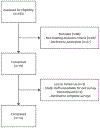Assessing Patient Experience and Orientation in the Emergency Department with Virtual Windows
- PMID: 35024006
- PMCID: PMC8749224
Assessing Patient Experience and Orientation in the Emergency Department with Virtual Windows
Abstract
Patients have benefitted from increasingly sophisticated diagnostic and therapeutic innovations over the years. However, the design of the physical hospital environment has garnered less attention. This may negatively impact a patient's experience and health. In areas of the hospital, such as the emergency department (ED), patients may spend hours, or even days, in a windowless environment. Studies have highlighted the importance of natural light and imagery, as they are essential in providing important stimuli to regulate circadian rhythm and orientation, and to mitigate the onset of certain medical conditions. In hospital locations where standard windows may be infeasible, the use of a virtual window may simulate the benefits of an actual window. In this pilot study, we assessed patient experience and orientation with virtual windows in the ED. We demonstrated that virtual windows are an acceptable technology that may improve patient experience and orientation.
Figures
References
-
- Iwamoto J et al., “Lower Incidence of In-Hospital Falls in Patients Hospitalized in Window Beds Than Nonwindow Beds,” J. Am. Med. Dir. Assoc, vol. 21, no. 4, pp. 476–480, Apr. 2020. - PubMed
-
- Shepley M, Gerbi R, Watson A, Imgrund S, and Zadeh R, “The Impact of Daylight and Views on ICU Patients and Staff,” HERD, vol. 5, pp. 46–60, Nov. 2012. - PubMed
-
- Buijs RM, Escobar C, and Swaab DF, “The circadian system and the balance of the autonomic nervous system,” Handb. Clin. Neurol, vol. 117, pp. 173–191, 2013. - PubMed
Grants and funding
LinkOut - more resources
Full Text Sources


